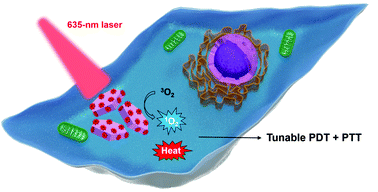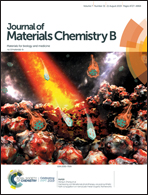Harnessing combinational phototherapy via post-synthetic PpIX conjugation on nanoscale metal–organic frameworks†
Abstract
Nanomaterial-mediated phototherapy, including photodynamic therapy (PDT) and photothermal therapy (PTT), is an effective anticancer intervention that relies on light activation of photoactive nanomaterials localized in tumors. Recently, combinational PDT/PTT offered a practical pathway to relieve resistance of monotherapy, surmount undesirable side effects and provide a synergistic effect to enhance phototherapeutic efficiency. Herein, we report a facile strategy to integrate protoporphyrin IX (PpIX) into nanoscale metal–organic frameworks (NMOFs) and control their photoactive properties for combinational cancer PDT and PTT. With optimized PpIX conjugation, the as-fabricated nanoparticles (nPCU NPs) exhibit (1) improved dispersibility and particle stability, (2) simultaneous generation of reactive oxygen species and heat effectively through activation by a single-wavelength laser of 635 nm, and (3) maintenance of porosity for further application as drug delivery vehicles. Moreover, in vitro investigation of nPCU NPs demonstrates effective cellular uptake, successful endosomal escape and enhanced phototherapeutic efficacy under both normoxic and hypoxic conditions. Therefore, this study developed a novel type of phototherapeutic nanoplatform with optimal properties for applicable cancer phototherapy.

- This article is part of the themed collection: 2019 Journal of Materials Chemistry B HOT Papers


 Please wait while we load your content...
Please wait while we load your content...